
| Objective: Exploring inside the Great Pyramid Location: Great Pyramid, Giza, Egypt Construction: Roughly 20,000 workers over 27 years |
What type of adventurer are you? Are you a scholarly archaeologist or an unapologetic tomb raider? You don’t have to be either to unravel the mysteries of the Great Pyramid of Giza. Climb dark tunnels and crawl through narrow shafts to the secret chamber containing Khufu’s sarcophagus. While you won’t have to worry about booby traps or solving puzzles, there is much to explore.
Great Pyramid of Khufu | Treasure Hunt | Giza Complex | Pyramid of Khafre | Pyramid of Menkaure | Great Sphinx
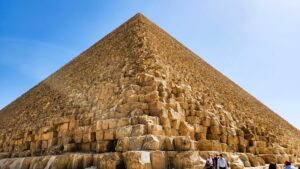
THE GREAT PYRAMID OF KHUFU
| Height: 481 feet Built: 2600 BCE (Old Kingdom) Materials: 2.3 million limestone blocks (2.5 to 15 tons) Purpose: Tomb of pharaoh Khufu |
This pyramid has seen untold sunrises and sunsets while newer civilizations have risen and fallen. After 4,600 years, it is still standing as the last of the Seven Wonders of the Ancient World. Khufu ordered the construction of the Great Pyramid on the Giza Plateau in the 26th century BCE. Egyptian pharaohs required houses of death to ease their journey into the afterlife. Of course, they were bringing their lavish treasures. They were not supporters of the saying “you can’t take it with you when you die.” The structure’s 2.3 million limestone blocks, weighing 2.5 to 15 tons protects the burial chamber. When you stand next to the base, the megalithic blocks inspire awe at the pyramid’s monumental scale.

LET THE TREASURE HUNT BEGIN
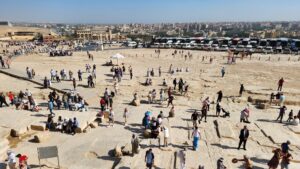
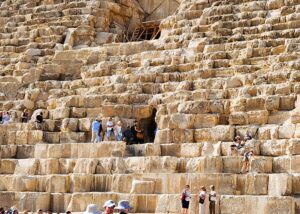
Waiting in Line
On the northern side, there is an entrance to the “secret” corridors through the Robber’s Tunnel. Tomb robbers cut a tunnel until they reached the secret passageways. The single-file path resembles a long queue for a Disneyland ride. Sweaty and tired explorers emerge from the dark. Hmmm, what have we signed up for?
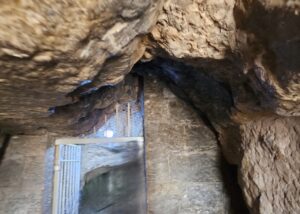
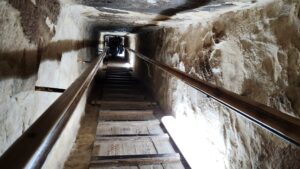
Not for the Claustrophobic
You wait for your turn to climb up a couple sloped ladders. Taking a low crouch, avoid scraping your back in the tight space. The Ascending Passageway is a large, confined, diagonal shaft with wooden floorboards. It is hot, steep, and long. Occasionally, you must squeeze to one side for people on their way down. The Grand Gallery continues at the same angle, climbing 69 feet from the 23rd level to the 48th level. The masonry here is truly impressive with smooth walls of closely fitting blocks rising 28 feet.
Just before the top, you must crawl through two low shafts. This antechamber was the last line of defense and granite stones once blocked the way.
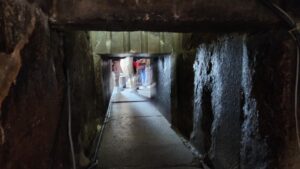
King’s Chamber
Eventually you reach the final granite vault. The King’s Chamber has a roof of nine slabs of granite preventing the weight of the pyramid from caving in. The chamber is a plain, unadorned, rectangular room with a simple empty sarcophagus. It is extremely hot with no air flow. You can sort of cool off by leaning on the cool stone walls.
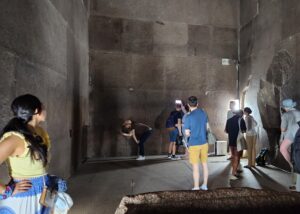
Grave robbers plundered the treasures soon after the sealing of the vault. Most likely, it was an inside job by the builders who literally knew where the bodies were. The room is empty and the walls are bare. All of the material goods that the pharaoh needed in the next world is no more. There is no ornate furniture, jewelry, lapis lazuli, gold ankhs, or papyrus with spells from the Book of the Dead. Robbers would have melted down precious metals and removed gems from jewelry to hide evidence of any crime. All that remains is a stone sarcophagus. There is no trace of the mummy. The tomb raiders probably dumped Khufu’s body outside. Not even curses on doors could scare off looters. Eventually, aboveground tombs were replaced by underground graves like at the Valley of the Kings, which hardly fared any better.
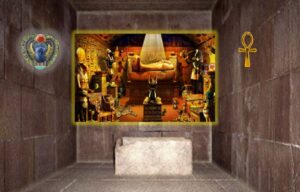
The Real Treasure
The real treasure of the Great Pyramid is not fortune and glory. It is the archeological significance to humanity and the mystery of its engineering marvels. As recently as 2023, a research team used cosmic rays to discover hidden chambers. The quest will continue for understanding its secrets and what ancient life was like.
For now, you will have to imagine what riches the vault once contained. In your mind’s eye, you can picture gleaming pyramids covered in white limestone casing stones and topped by a golden capstone (pyramidion).

During the Middle Ages, a sultan used most of the limestone to build residences in Cairo. Muhammad Ali also repurposed the white limestone for the Alabaster Mosque.
THREE MAIN PYRAMIDS AND SIX OTHERS
The pharaohs excelled at preserving generational wealth. The pyramids at Giza represent three generations. In addition to the Great Pyramid, the three main pyramids include the Pyramid of Khafre and the Pyramid of Menkaure. There are nine total pyramids at Giza for the pharaoh’s wives and other esteemed family members.

PYRAMID OF KHAFRE
| Height: 448 feet Built: 2550 BCE (Old Kingdom) Base: Square base with 704 feet on each side Angle: 53 degrees Purpose: Tomb of Khafre, son of Khufu |
Khafre was the son of Khufu. His pyramid still has some of the white exterior casing intact at the apex of the capstone. This pyramid is at the center of the three main pyramids. Compared with the crowds at the Great Pyramid, it is a sea of tranquility. You can stroll aimlessly along the shifting sands.

PYRAMID OF MENKAURE
| Height: 213 feet Built: 2510 BCE (Old Kingdom) Materials: Limestone, red granite Purpose: Tomb of Menkaure, grandson of Khufu |
Each successive pyramid is considerably smaller. The building costs of each prior one meant there was less for the next one. Menkaure was the grandson of Khufu. The grandson’s pyramid only takes 10 minutes to walk around. There are columns and structures you can explore. There are still a few rows of granite at the bottom. Muhammad Ali stripped out much of the granite until realizing it would be cheaper to use nearby quarries. Broken chunks of red granite lay around the base. There are several no climbing signs, but that has not stopped someone from scaling one of the wives’ pyramids.

GREAT SPHINX
| Height: 66 feet Built: 2500 BCE (Old Kingdom) Purpose: Tomb of Khafre, son of Khufu |
Unlike the Greek sphinxes that would ask riddles and kill unfortunate guessers, Egyptian sphinxes were protectors. The Great Sphinx seems to be guarding the pyramids behind it. It has the face of Pharaoh Khafre and the body of a resting lion. Its paws and forearms rest on the ground and its tail wraps around its side.
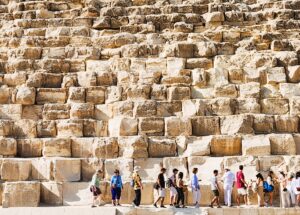
Keep Exploring!
Africa | Antarctica | Asia | Australia | Europe | Middle East | North America | South America

